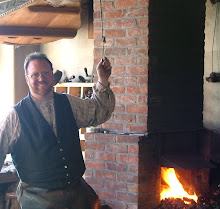From April until early July it is cooler in the building than the outside temperature. That is a product of working in such a strongly built stone building. The building is made of around one hundred tons of stone. The rear wall and coal bin are build below grade into the hillside. And finally, the shop itself is in the shade of a large, tree lined ridge much of the day. While the shop was originally built in the village of New Berlin, it was tucked into a similar hillside. The builders understood those advantages. The shop enjoys natural cooling well into early August. The shop only becomes truly hot for about 2 weeks in August.
Our shop is used not just in the summer, but in the fall, winter, and spring as well. Cooperstown, NY has a long and cold winter. Nights are below freezing from November to March, and lows dip below 0F in the depth of winter. How do we keep warm? The smoke and hot air from the forges goes right up the massive chimneys. Radiant heat from the fire does warm the smith, but does little for the shop. Our wood-burning stove carries the burden of heating the shop.


Our stove is an exact reproduction of an original in the Museum collection. Reproductions were made of the original stove so that it could be preserved. This style of stove is usually called a “box stove”, as it is rectangular and is made of 6 cast iron panels. Large and stout, it can hold 4 chunks of oak or ash wood at a time. October through December, and March through May it can heat the shop. From late December to early March is just gives you a better grade of cold!
 During the coldest months the stove creates a pocket of warm air within the larger workshop. That is usually just enough. The work in the shop is very physical. It is common to shed layers while working at the forge until by lunch we are working in just long sleeves. That leads to the question of defining “warm”. By February the shop’s stone walls have cooled to below freezing, and wear a permanent coat of frost. In a modern workplace 50 degrees F. would be seen as punishing cold. In the 19th century it would be quite warm for physical work.
During the coldest months the stove creates a pocket of warm air within the larger workshop. That is usually just enough. The work in the shop is very physical. It is common to shed layers while working at the forge until by lunch we are working in just long sleeves. That leads to the question of defining “warm”. By February the shop’s stone walls have cooled to below freezing, and wear a permanent coat of frost. In a modern workplace 50 degrees F. would be seen as punishing cold. In the 19th century it would be quite warm for physical work.
 During the coldest months the stove creates a pocket of warm air within the larger workshop. That is usually just enough. The work in the shop is very physical. It is common to shed layers while working at the forge until by lunch we are working in just long sleeves. That leads to the question of defining “warm”. By February the shop’s stone walls have cooled to below freezing, and wear a permanent coat of frost. In a modern workplace 50 degrees F. would be seen as punishing cold. In the 19th century it would be quite warm for physical work.
During the coldest months the stove creates a pocket of warm air within the larger workshop. That is usually just enough. The work in the shop is very physical. It is common to shed layers while working at the forge until by lunch we are working in just long sleeves. That leads to the question of defining “warm”. By February the shop’s stone walls have cooled to below freezing, and wear a permanent coat of frost. In a modern workplace 50 degrees F. would be seen as punishing cold. In the 19th century it would be quite warm for physical work.
It is more than 1/8th of a mile from the parking lot to the Blacksmith Shop. Our daytime temperature in February can be below 20F. By the time visitors or staff come charging into the shop and stomp the snow off their boots the shop seems nice and warm! At the end of the day when the light is fading, the tools have been returned to their places and the forge fire is low. We pull a chair up to the desk by the stove. As we make note of the tasks awaiting us the next day one thing in certain: each new day starts with a new fire.

The Heating Ontario air conditioning contractors specialize in finding the right system for your home. No matter what size your home is, you can be sure our expert technicians will devise a plan to keep your home cool without breaking the bank.
ReplyDeleteAir Conditioning Contractor Toronto
Everything in detail, I like this blog and I bookmarked it and also shared my other relatives.
ReplyDeleteHeating and Cooling Mississauga